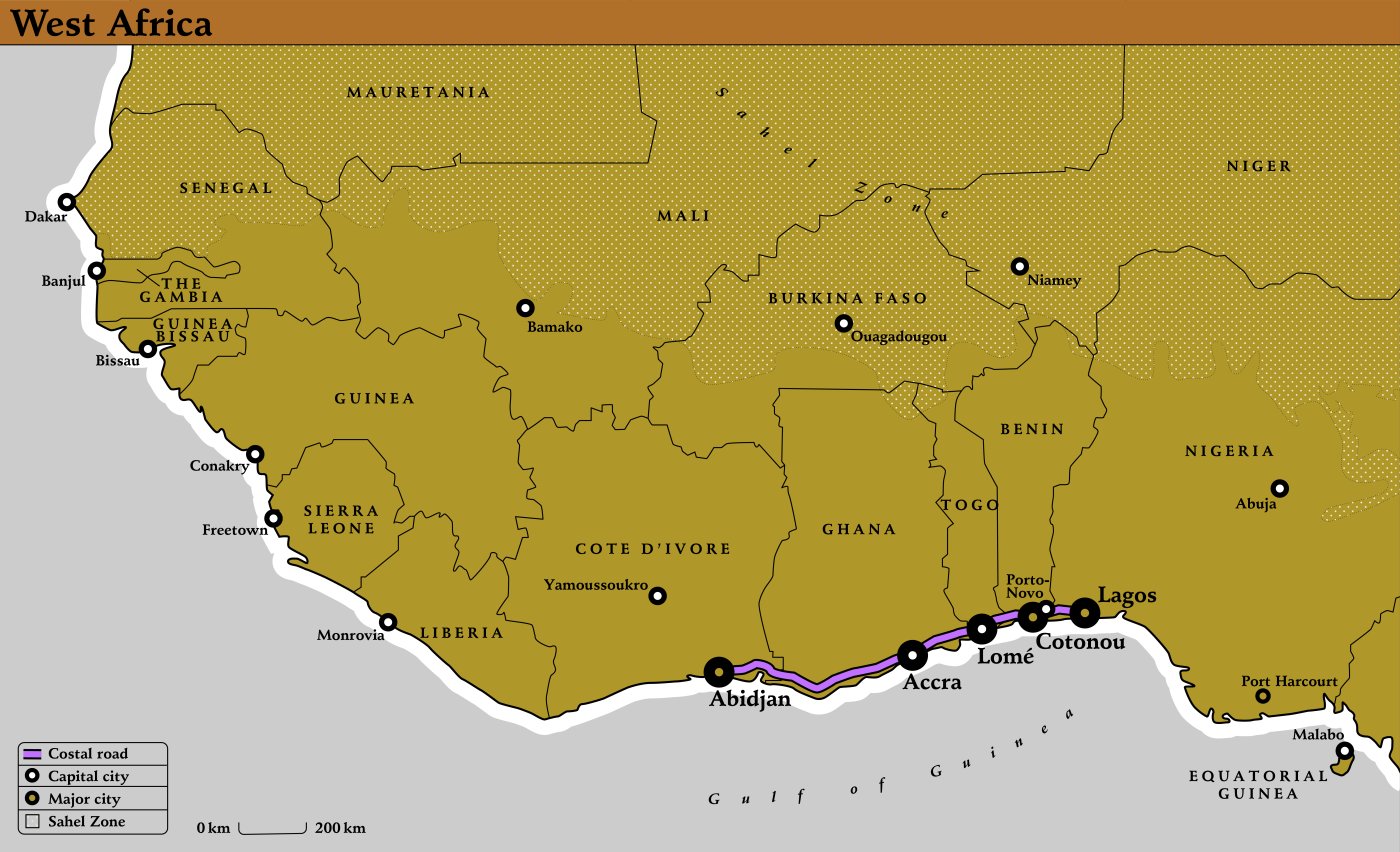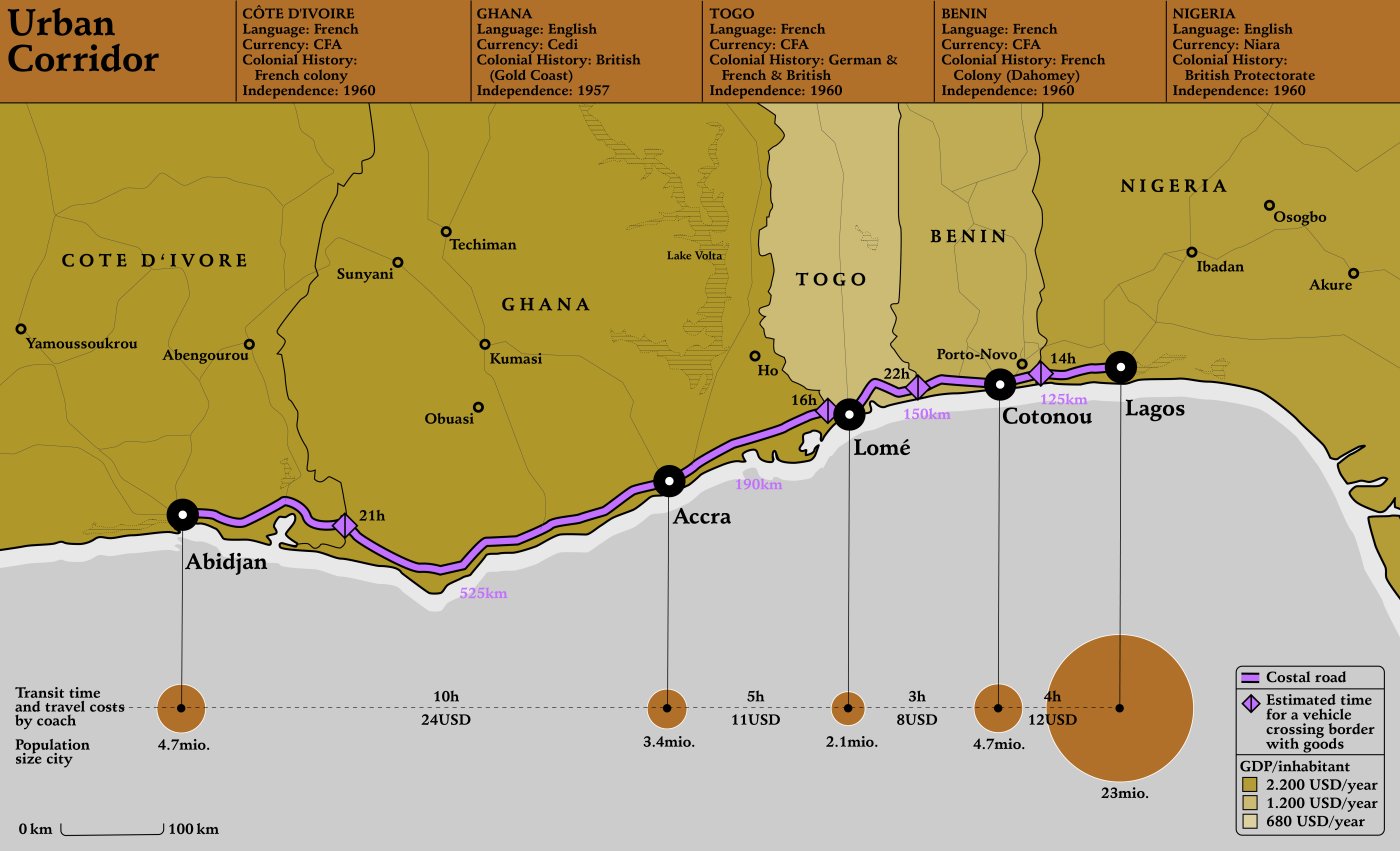The Lagos-Abidjan Corridor
The West African urban corridor is one of the fastest growing mega regions in the world. Along the Gulf of Guinea, stretching from Lagos to Abidjan, a number of urban areas are growing together to form a remarkable polycentric corridor. The corridor spans one thousand kilometres from Lagos in Nigeria to Abidjan in the Ivory Coast, passing though the Beninese cities of Porto Novo and Cotonou, the Togolese capital Lomé and the Ghanaian capital Accra. Strung together by a coastal highway, the corridor is made up of major cities, but also market towns, ports, borders, and villages. Current population estimates stand as such: Lagos 23 million, Abidjan 4.7 million, Porto Novo 0.9 million, Cotonou 2.4 million, Lomé 2.1 million and Accra 3.4 million.
Such transnational metropolitan areas raise fundamental questions for future urban transitions. This is particularly the case in West Africa, where much urbanisation is still to occur. The region is experiencing the highest rate of urban growth on the continent and it is predicted that it will soon be home to more than 50 million people. 1 Over the course of the past decade, it has become widely recognised that “traditional city-based urbanisation is moving towards regional urbanisation patterns, including the emergence of city regions and their associated urban corridors, creating what is known as mega urban regions”2 . In this particular case UN Habitat has suggested that the mushrooming of settlement along the Guinea Gulf, is forming “arguably the most clustered urban corridor in Sub-Saharan Africa.”3
The Lagos-Abidjan corridor has much to tell us about the future of urbanisation in West Africa. It sheds light on current forms of accelerated urbanisation that are occurring in the Global South, and the particular urban forms this is producing. Such urban dynamics are highly contrasted to the well-known trajectories of urbanisation in Europe and North America. They are for example, taking place without substantial industrialisation and job creation. How, in the absence of formal and secure employment, is migration a key strategy for urban livelihoods? And what kind of urban forms is this producing? How is migration connecting various settings? Who is mobile, and who is staying put?
The Lagos-Abidjan corridor can offer up wider insights into how migration transforms urban locations, and mitigates economic and social vulnerabilities. It is furthermore a setting from which we can challenge current conceptualisations of the urban fabric, and offer more detailed and precise accounts of the processes producing this urban fabric. This involves thinking beyond classic understandings of the urban being a city centre and considering more extended, linear forms of urbanisation. As such the Lagos-Abidjan presents an ideal location from which we can think about urban diversity, the contribution of migrants to city-making and emerging forms of extended urbanisation.
The relevance of megaregions such as the Lagos-Abidjan corridor is only set to increase. A recent study predicts by the OECD indicates that “in Africa the evolution of population settlement is so rapid that everything indicates that the process of emergence of this type of agglomeration will intensify”.4 These new morphologies require both practitioners and researchers to reassess the focus and tools of their trade. The rise of such regions raises vital questions for urban research, and interrogates current thinking about urban theory, urban society and urban policy.5 Such territories bring with them new challenges in terms of governance and sustainability, as well as opening up new development paths.
The cities along the corridor have long-standing backlogs in terms of investment and infrastructure. Examined one by one, they have “exhibited incongruous physical development, absence of a resilient tax base and a general lack of sustainable economic development patterns”.6 These issues have been “reinforced by an unfortunate lack of policies and interventions, as well as by the Structural Adjustment Programmes”7. Yet in West Africa, much hope in solving current-day challenges is pinned on the future of the Lagos-Abidjan corridor.
For the commissioner of Economic Community of West African States (ECOWAS) the corridor is “a vital key for regional integration in view of stimulating economic growth and eliminating poverty”8 The Lagos-Abidjan corridor has far more potential when compared to the sparsely populated and underdeveloped northern hinterland. This is further consolidated by the relative security and wealth of the coastline that centralises both economic infrastructure and political institutions, in comparison to heightened poverty, and ongoing security crisis in the Sahel9.
The corridor’s potential lies in the high levels of diversity encountered along the coast. Whilst the cities along the corridor have experienced common deficits they each have a specific trajectory and are highly differentiated. This differentiation produces opportunity in and of itself. The corridor traces a line across both Anglophone and Francophone West Africa, joining the dots between a series of different political regimes, currencies, economic markets and linguistic groups. It is embedded within the Economic Community of West African States that seeks to promote the free circulation of people and goods along the corridor,10 but is disjointed by national borders. However, these borders also create opportunity in the region, producing added value and exchange-value by creating difference, for example in currencies or available goods. And, despite the slow traffic, the spatial proximity between the main cities along the corridor is flagrant, with Cotonou at no more than 150 km from Lagos and 350 km from Accra.
The close proximity of such diverse cities along the corridor is an opportunity to be leveraged. Indeed, as AbdouMaliq Simone writes, “the most important consideration of regional urban development planning would emphasize how the differentiated resource bases, histories, and geo-economic positions of cities and towns could be most productively connected in order to create regional domains – crossing distinct national territories or rural-urban divides – with a density of synergistic relationships among diverse economic activities”11. He adds that the most obvious example is how “transactions of all kinds could be maximised between Abidjan, Accra, Lomé, Cotonou, and Lagos – long imagined to be the elements of a mega-urban region”12.
The corridor plays an important part in the political imaginary of post-colonial regional integration, abstractions substantiated through the creation of commissions, organisations and bodies to improve coordination between member states across this trans-national axis. However this corridor is also experienced on the ground as people jump on and off buses, travel up from one spot to another or go in hunt for a job or a spot to trade from.


